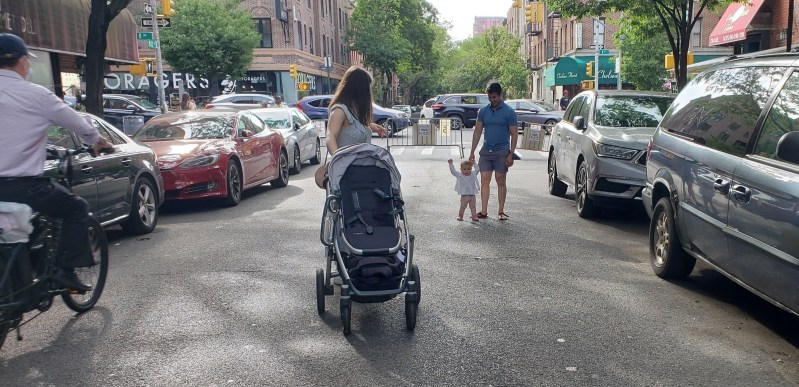Community Board 4 Wants Shared Street on W. 22nd — And Continued Open Street in the Meantime

A Manhattan community board is calling on the city to turn the embattled W. 22nd open street into a permanent shared street and to keep the current traffic limitations in place in the meantime — the latest twist in a saga that has seen the popular play street under fire from a small group of opponents.
On Wednesday night, Community Board 4 voted overwhelmingly in favor of urging the Department of Transportation to maintain local access only at five miles per hour between Seventh and Eighth avenues, even as a group of locals has been trying to dismantle the open street and return the stretch to regular through-traffic at 25 mph.
In its vote, the full board voted to ask the DOT to install a shared street and study its neighborhood impacts, following a recommendation by its transportation committee from a marathon meeting last month pitting supporters of safe streets against those who want more car access.
For shared streets, DOT installs bump-outs to narrow the street and retard drivers, while reclaiming more space for people outside of cars.
The conversion would get rid of the need for the metal barriers that have been at the end the block since early in the pandemic; both sides of the debate agreed that the barricades are a nuisance to move back and forth.
The famously progressive board also urged officials to cut the hours of the open street in half from 8 a.m.–8 p.m. daily to just 10 a.m.–4 p.m. and rearrange the barricades from a line into a chicane, so motorists can navigate around them without having to get out of their car, but would still be encouraged to slow down.
The board’s letter to the DOT said the move would reduce the growing tension between neighbors around the restrictions as DOT works on a longer-term solution.
Volunteers with the Chelsea West 200 Block Association have run the W. 22nd open street since the start of the Covid-19 outbreak in 2020, and they held a workshop in October to come up with a longer-term revamp of the block.
Three-decade resident and urban planner Tom Lunke presented three permanent conversion options for W. 22nd last month:
- Raising the street to the curb level creating a continuous space like a Dutch woonerf, with planters and benches on the sides to force drivers to go around them and slow down.
- A cheaper version of that, a shared street like DOT has installed in other parts of the city, which also has planters and benches in bulb-outs to calm traffic, but without a raised street.
- The installation of automated gates, but no other street elements, to slow drivers down along the block, so gates wouldn’t need to be moved by hand anymore.
Residents and members of the transportation committee said the street provided a valuable outdoor space and a great template to reduce room for cars in an area which has the fourth-highest traffic volumes in the city, even though nearly nine in 10 households live car free.
“My question would be, ‘Why not every street? Why is every street in Chelsea not five miles an hour with planters and benches — that’s what I would like to see,” said committee member Charlie Todd.
One 20-year resident of the block who said she is immunocompromised expressed nothing but high praise for the open street.
“This street has basically saved my life during this time period,” said Christina Carrad. “Having this space where you can just go — and this street has given me that plus community, I have met neighbors that I have never met.”
Carrad added that, contrary to claims by opponents of the open street about access issues, she has never had a problem ordering an Uber to get to the hospital or receiving packages.
A parking garage, one of the few business on the block, did cut its overnight opening hours and lay off half its staff during the pandemic, according to a spokesman during the meeting, but the rep said he would be fine with lowering speed limits.
“We’re fine with people driving at a limit of five miles per hour, that’s in everyone’s interest as long as cars can still get down the street because we’re still trying to operate a business,” said Spencer Stiefel.





